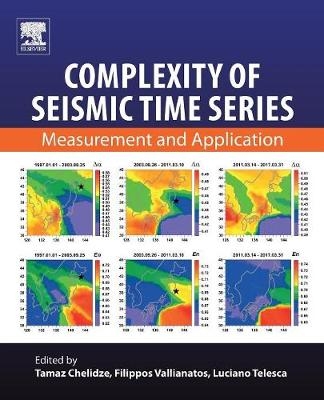
Complexity of Seismic Time Series
Elsevier Science Publishing Co Inc (Verlag)
978-0-12-813138-1 (ISBN)
Tamaz Chelidze is a Professor of Geophysics at Tbilisi State University and a member of the Georgian National Academy of Sciences, M. Nodia Institute of Geophysics. He is Director of the European Centre “Geodynamical Hazards of High Dams Council of Europe, and Chairman of the Georgian National Committee of IUGG. His professional activity is related to complexity analysis of seismic time series; experimental and theoretical research in the physics of heterogeneous media; surface science; prospecting and environmental geophysics; archaeogeophysics; percolation, fractal and nonlinear models of fracture; nonlinear dynamics in geophysics; elasticity and seismicity; triggering and synchronization of stick-slip and seismic process seismohydraulics of underground water; geothermy; seismic hazard and risk assessment; earthquake prediction; multi-hazards and multi-risks; and early warning systems. He was an Invited Professor of Strasbourg University from 1987 to 1992; Rennes University from 1994 to 1997; and Ecole Normale Superieure (Paris) in 2000. He has contributed to 300 scientific publications, 70 papers in high rank journals, and 8 chapters in monographs. Filippos Vallianatos is a Professor of Geophysics and Seismology in the School of Environment and Natural Resources Engineering at the Technological Educational Institute of Crete. He is the holder of UNESCO Chair of Solid Earth Physics and Geohazards Risk Reduction. His research activity Is focused on Solid Earth physics, approaching it using the principles of Complexity Geophysics and Seismology involved in the dynamics of the Earth's crust and by studying the fundamental mechanics of earth processes & geohazards from rock physics to geodynamic scales. He has authored or co-authored more than 150 publications in international journals along with many chapters or monographs. Luciano Telesca is a research scientist for the Institute of Methodologies for Environmental Analysis of the National Research Council of Italy. His research activity is focused on complex methods of time series analysis for the study of geophysical and environmental processes, with special emphasis on earthquake processes. He coordinated numerous international bilateral research projects, most of them aimed at the development and application of advanced statistical tools for the understanding of earth processes. He was awarded professorship by the Chinese Academy of Sciences. He has co-authored more than 280 publications in international journal along with several book chapters.
I. Complexity Measurement in Seismograms and Natural and Artificial Time Series of EQs (Catalogs) 1. Analysis of Complexity in Seismic Time Sets: Case Study for Caucasus 2. Non-Extensive Statistical Seismology: An Overview 3. Point-Processes Applied to Seismology: Epidemic Type Aftershock Sequence (ETAS) Model, Results and Limits 4. Fractal, Informational and Topological Methods for the Analysis of Discrete and Continuous Seismic Time Series: An Overview 5. Modelling of Persistent Time Series by the Nonlinear Langevin Equation 6. Synchronization of Geophysical Fields Fluctuations 7. Natural Time Analysis of Seismic Time Series
II. Complexity of Time Series of Stick-Slip (Models of Seismic Process) 8. Complexity in Laboratory Seismology. From Electrical and Acoustic Emissions to fracture 9. Complexity and Synchronization Analysis in Natural and Dynamically Forced Stick-Slip: a Review
III. Complexity in Earthquake Generation and Seismic Hazard Assessment 10. Complexity and Time-Dependent SHA: Should We Use Fuzzy, Approximate and Prone-to-Errors Prediction Models to Overcome the Limitations of Time-Independent Models? 11. Are Seismogenetic Systems Random or Organized? A Treatise of their Statistical Nature Based on the Seismicity of the North-Northeast Pacific Rim 13. Phase Space Portraits of Earthquake Time Series 12. Four-Stage Model of Earthquake Generation in Terms of Fracture-Induced Electromagnetic Emissions: A Review
| Erscheinungsdatum | 04.08.2018 |
|---|---|
| Sprache | englisch |
| Maße | 191 x 235 mm |
| Gewicht | 1110 g |
| Themenwelt | Mathematik / Informatik ► Informatik |
| Naturwissenschaften ► Geowissenschaften ► Geologie | |
| Naturwissenschaften ► Geowissenschaften ► Geophysik | |
| ISBN-10 | 0-12-813138-1 / 0128131381 |
| ISBN-13 | 978-0-12-813138-1 / 9780128131381 |
| Zustand | Neuware |
| Haben Sie eine Frage zum Produkt? |
aus dem Bereich


